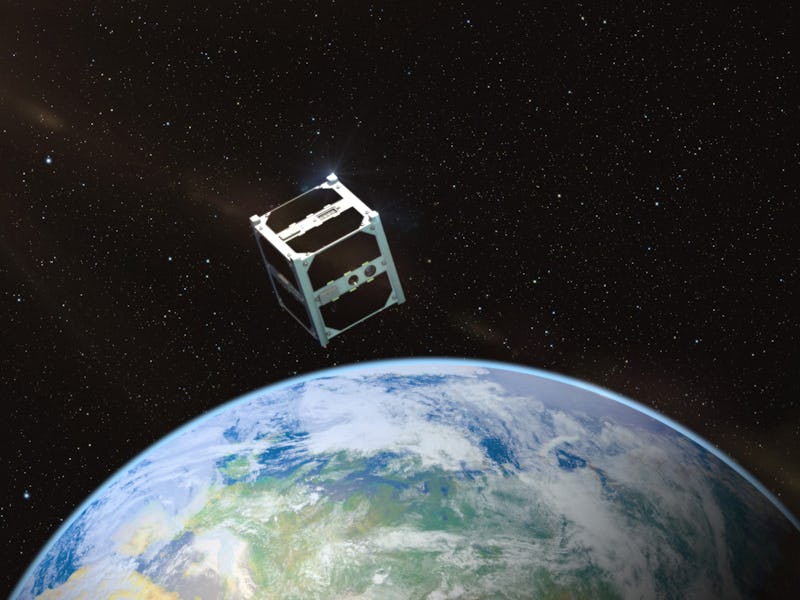What If You Could Upload Your DNA and Thoughts to Space?
“We can take humanity on every single space mission.”

It’s fair to say the Experimental Cosmology Group at the University of California, Santa Barbara is obsessed with strange and unique ideas regarding astrophysics and space exploration. Take their latest project, Voices of Humanity, which offers to collect digital mementos from any person in the world — ranging from documents, audio recordings, writings, movies, pictures, social media posts, or even digital DNA — then send that into space on a wafer-sized spacecraft and perhaps even an interstellar laser beam.
Voices of Humanity is the brainchild of UCSB professor Phillip Lubin, head of the Experimental Cosmology Group, and Travis Brashears, an undergrad in the lab. The lab houses a NASA program called DEEP-IN, which is focused on developing “directed energy relativistic spacecraft”; in plain English, that’s “spacecraft that can achieve relativistic speed an allow for the first interstellar mission,” Lubin tells Inverse. DEEP-IN was recently chosen as part of the second phase of the NASA Innovative Advanced Concepts (NIAC) program.
At some point, the pair began discussing how we would represent ourselves in space, “what we would like on these spacecraft that first go to the stars that would represent humanity,” Lubin says. “Not just technology on board, but how could we represent humanity as a whole?”
Brashears and Lupin soon settled on a very simple idea: create a small wafer-like chip (just four-by-four inches and about the width of a human hair), upload people’s digital information onto it, and launch it into space. A more audacious concept is to build a laser beam that can encode that information (similar to the way one encodes information into a fiber optic) and fire it off towards cosmic objects at even farther distances.
The Humanity Chip
“Anything that you can convert into digital form … can go into space,” says Brashears. “We could actually put your DNA on this thing. The options for people are vast.”
“We can now take humanity with us on these missions that will take us to the stars,” added Lubin. “We can take humanity on every single space mission.”
The “Humanity Chip” is surprisingly cheap. The primary costs, explain Lubin and Brashears, mostly have to do with collecting the data and downloading it to the chip. “And then of course we have to launch it, and launches are not cheap,” says Lubin. The pair is currently working with space launch providers to figure out if they’ll be able to send the wafers up to low Earth orbit sometime in 2017.
After that, the goal is to ship more spacecraft out to the moon, Mars, and other locales further into deep space.
That shouldn’t be much of obstacle, however. Brashears and Lubin have specially designed the Humanity Chip to be ultra-lightweight and compact so that it won’t actually impact other missions carrying the spacecraft. For those launches, the chips are simply an innocuous experiment with no risks involved. The ground-based laser beam, on the other hand, is more expensive and requires more time to construct and operate.
And yet in both cases, the potential upsides are enormous. “These things can be strewn like seeds throughout space,” said Lubin. Imagine a future robotic rover carrying a chip as it zoomed through the Martian landscape, and there’s an audio file of you singing that can be played on the planet. “Suddenly, in a matter of speaking you’re now on Mars,” says Lubin. “It’s a very personal connection. You want people to have this immortal connection to the universe.”
And this isn’t a project for the ultra-geek. Lubin argues there’s lots of room for people to use Voices of Humanity and its technology in whatever way they see fit. Though Lubin envisions more personal applications, it’s dynamic enough to change as the technologies evolve. “People could do whatever they want with this,” he says.
This isn’t Lubin’s first foray into the design of lasers and nanocrafts — he’s also involved with the Breakthrough Starshot initiative that aims to send gram-scale spacecraft to Alpha Centauri to search for extraterrestrial life. In comparison to that project, Voices of Humanity is a gentler walk.
One potential application for the project actually goes back to extraterrestrial life: using Voices of Humanity as an outlet for transmitting messages into space for intelligent aliens to find. Although nearly all SETI investigations are conducted passively (i.e. we listen for messages, but do not transmit), Lubin makes the point that Earth’s been transmitting messages for at least the last century. “Everything time you pick up a cell phone or turn on a flashlight, you’re transmitting,” Lubin points out. “It’s always going on.”
In fact, Lubin believes that messages could conceivably be 100 light-years into space. Fears that a hostile alien will find these messages and storm our planet, however, are overblown. “If you’re worried about someone eating you, you’ve got some time on your hands,” he says.
Nevertheless, the project needs to reach its funding goals if it’s going to actually succeed. With just about a week to go, Brashears and Lubin are still shy of their $30,000 minimum goal to send the Humanity Chip into orbit next year, and some ways away from their $100,000 stretch goal to build the laser beam. There’s still time to donate, so if you’re interested in seeing this project come to fruition — or better yet, seeing a part of yourself blasted off into outer space — head over to their Kickstarter page. And hey: The project is currently offering a limited time discount on DNA uploads.